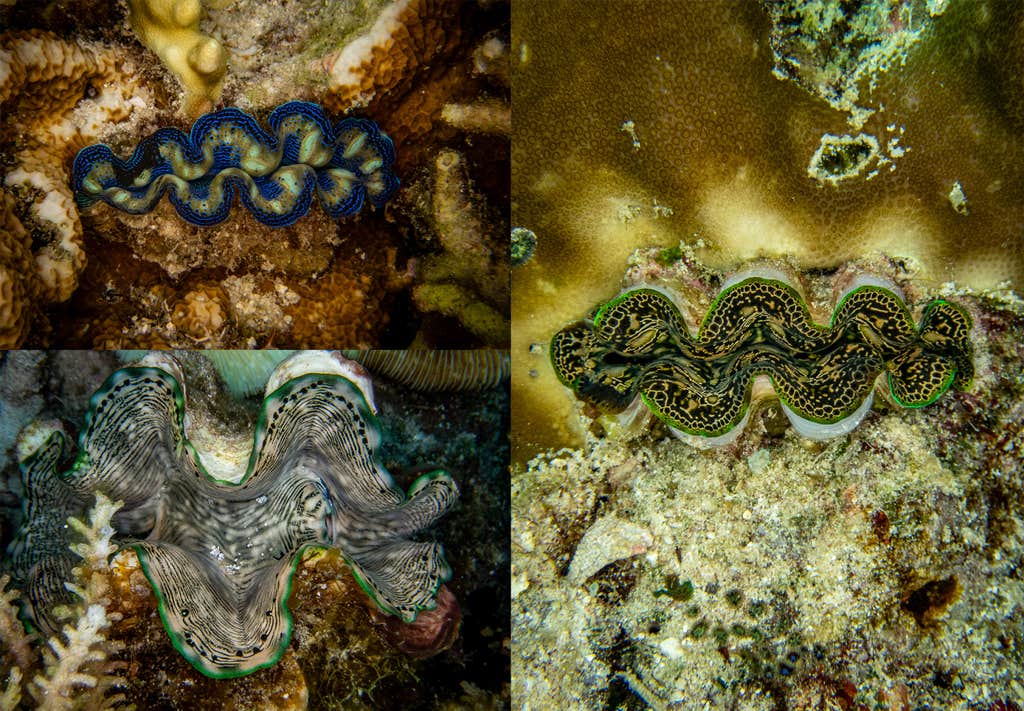You might think tree leaves were the best thing nature had come up with to harvest the sun’s light. But they are nowhere near as efficient at turning photons into chemical energy as giant clams. These creatures’ fleshy, colorful mantle—the wavy, psychedelic-patterned tissue sandwiched between their shells—could even inspire more efficient solar energy technology.
Unfortunately, there are a lot of other things people find attractive about giant clams: There’s the spectacle of their proportions—the largest species of giant clam, Tridacna gigas, can grow almost five feet in length and weigh around 700 pounds—which leads some people to repurpose the shells as decorative ornaments. Their meat is also considered a delicacy in many places, from Japan to France, which has led to an overfishing problem. Add to this their susceptibility to the warming effects of climate change, and it’s easy to see why a new assessment shifted T. gigas’ status from “vulnerable” to “critically endangered,” the highest level of extinction risk.
If the giant clam becomes extinct, it will have huge impacts on tropical oceans.
Ruiqi Li, a postdoctoral researcher at the University of Colorado’s Museum of Natural History, and Mei Lin Neo, a senior research fellow at the National University of Singapore, co-authored the assessment. They found that T. gigas’ population numbers have dramatically dwindled over the past century, dropping by 80 percent. It’s not clear how many individual giant clams still exist.
“Unlike mammals like mountain lions, it is hard to estimate the population size of marine invertebrates given the nature of marine habitats,” writes Ri in an email. So they calculated their estimate by counting the number of populations of giant clams that remain, a standard way of assessing extinction risk when the actual population size is unavailable. Like coral reefs, giant clams play central roles in their ecosystem niches, mainly the shallow waters surrounding the coasts of Malaysia, Australia, and Fiji. If the giant clam becomes extinct, it will have huge impacts on tropical oceans.

The tremendous bodies of these clams are also home to symbiotic algae, much like the algae that live in partnership with coral. The clam keeps the algae safe, and the algae nourish the clam via their photosynthesis. Translucent cells in the clam’s flesh called iridocytes scatter incoming light, which, when it aligns in just the right geometry within the mantle, makes it accessible and efficient for the algae to turn it into energy—for themselves and for their giant clam hosts.
In a 2024 study, Yale University biophysicist Alison Sweeney and her colleagues note that giant clams’ quantum efficiency—how well they convert photons to electrons—was 67 percent. (Leaves in a tropical environment, by contrast, work at 14 percent quantum efficiency.) This radical efficiency is inspiring some scientists to look to the dynamics between the algae and the clam to design better solar energy technology
If we want to learn from nature’s designs to improve our own technology, we’ll have to act to preserve Earth’s rich biodiversity. That’s where efforts like Li’s, using up-to-date results to drive new policy, can make a difference. He thinks more biologists should be doing it. “Evolutionary biologists should be devoting some time to population assessment and conservation, especially people who work on invertebrates,” Ri writes in an email. “Invertebrates make up over 95 percent of all animal species on Earth, but they receive so little attention compared to mammals.”
The focus on mammals is understandable. They are like us, and so understanding them helps us understand ourselves. But to gaze into the hypnotizing mantle of a giant clam is to appreciate the radical variety of life—and in that radical variety may lie the solutions to some of Earth’s most pressing problems. ![]()
Lead photo: Ruiqi Li / University of Colorado, Boulder


































